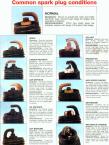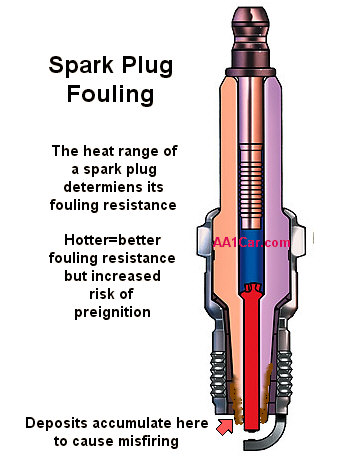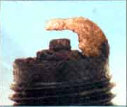
Home, Auto Repair Library, Auto Parts, Accessories, Tools, Manuals & Books, Car BLOG, Links, Index



Spark plug fouling is a common cause of engine misfire. When a spark plug becomes fouled for any reason, the spark plug will fail to fire and ignite the air/fuel mixture. This causes a misfire, a loss of power and fuel economy, and an increase in tailpipe hydrocarbon (HC) emissions.
Spark plugs are designed to be self-cleaning up to a point. When the engine is running, the ceramic shell that surrounds the center electrode gets hot and helps to burn off any fuel or oil ash deposits that might otherwise foul the spark plug. The "heat range" of the spark plug determines its operating temperature and its built-in fouling resistance. The plugs should be hot enough to prevent fouling but not so hot that they increase the risk of preignition and detonation. The spark plugs that are specified for your engine by the spark plug manufacturer should be correct for your vehicle application.
Full throttle acceleration and highway driving is good for spark plugs because it generates heat that helps keep the spark plugs clean. Short trip stop-and-go city driving and prolonged idling, on the other hand, are NOT good for the plugs because the plugs may not get hot enough to burn off all of the deposits. So as deposits accumulate, the risk of misfire goes up. And if the plugs get dirty enough, they will misfire. The electrical energy from the ignition coil that normally creates the spark will short circuit to ground across the deposits on the center electrode instead of jumping across the electrode gap to ignite the air/fuel mixture.

On 1996 and newer vehicles with OBD II, spark plug misfiring will usually turn on the Check Engine light and set one or more P030X misfire codes where "X" is the number of the cylinder that is misfiring. Your vehicle will NOT pass an emissions test with a Check Engine light on or misfire codes present.
If your spark plugs are fouled and misfiring because you have been driving your vehicle infrequently, or you have only been driving short distances (only a few miles per trip), or you have been letting your engine idle for long periods of time (15 minutes or more), try this: Take your vehicle out on the highway, accelerate quickly and drive it at highway speeds for 15 to 20 minutes. This should clean the plugs if the cause of the fouling is nothing unusual.
If the spark plugs continue to misfire because of fouling, they may be dirty or worn. Remove and inspect the spark plugs, and either clean or replace them as needed. Auto Parts stores sell spark plug cleaner devices that sand blast the end of the spark plug to remove deposits. If you use one of these devices,make sure no sand remains trapped between the spark plug electrode and shell before they go back in your engine. Also, be sure to regap the spark plug electrode gap back to specifications (which requires a spark plug gapping tool or feeler gauge). The recommended gap is usually specified on an underhood emissions decal in the engine compartment.
Reading the spark plugs can tell you why they are fouling:
 Click the image to view the spark plug chart.
Click the image to view the spark plug chart.
If the spark plugs are really dirty, worn or you don't want to try cleaning them, throw the old plug in the trash and install a new set of spark plugs. Make sure the spark plugs are the correct number for your engine application, and that they are gapped correctly. Most spark plugs are pregapped, but the gap may not be correct for your engine application.
If you can't avoid a lot of idling or short trip driving, refer to the spark plug supplier's catalog for a spark plug that is one heat range HOTTER than the standard spark plugs specified for your engine. Increasing the heat range slightly can improve fouling resistance by helping the plugs run hotter.
If you have a modified performance engine, however, you might want to install spark plugs that are one heat range COLDER than the standard spark plugs that are specified for your engine. High performance engines produce more heat and are at greater risk of engine-damaging detonation, so going with a slightly colder spark plug is often recommended to reduce the risk of detonation. The trade-off, however, may be an increased tendency to foul if the engine is idled too long or only driven at slow speed (as when driving around at a cruise night event).

If your spark plugs are fouling and keep fouling out, you probably have an engine problem. Normal spark plug deposits are typically light tan or brown in color. Black deposits or heavy ash deposits usually indicates trouble. Some common causes of spark plug fouling include:
Worn or damaged valve guides or valve guide seals. Problems here can allow oil to dribble down the valve stems and enter the combustion chamber. Oil will form heavy black wet oily deposits on the spark plugs.
Worn or damaged piston rings, or worn or damaged engine cylinders. Badly worn piston rings, broken or cracked piston rings, grooves or scoring in the cylinder walls, or even piston rings that have been installed upside down can allow oil to get into the combustion chamber and foul the spark plugs.
Rich fuel mixture. This will produce black fluffy deposits on the spark plugs. If only one or two spark plugs are affected, the underlying cause may be a leaky fuel injector. If all of the spark plugs show heavy dry carbon fouling, the rich fuel mixture may be caused by too much fuel pressure (check for a defective fuel pressure regulator or a plugged fuel return line). A defective oxygen sensor that reads lean all the time can also make the fuel mixture run rich. Check fuel trim readings with a scan tool to see if the engine is running rich (negative fuel trim numbers that are -8 to -10 or more would tell you the engine is running rich). On an older carbureted engine, a rich fuel mixture can be caused by a leaky float, incorrect float setting inside the fuel bowl, a leaky fuel inlet needle valve, or incorrect jetting (too large).
Leaky Head Gasket. This is really bad news because a leaky head gasket can be very expensive to repair. If coolant seeps into the combustion chamber, it will form fouling deposits on the spark plug. A fouled spark plug may be an early sign that a head gasket is starting to leak. The cheap fix here wold be to add a bottle of cooling system sealer or head gasket sealer to the cooling system and hope it seals the leak - at least temporarily.

Wet spark plugs means the spark plugs are not firing. The spark plugs are coated with unburned gasoline, which allows the ignition voltage to short circuit to ground instead of jumping across the electrode gap normally. Wet fouled spark plugs can be caused by flooding the engine when attempting to start a cold engine. This was a common problem on older carbureted engines and could be caused by pumping the accelerator pedal excessively, a choke that was sticking shut, or internal carburetor problems such as a bad float or leaky inlet valve that allowed too much fuel into the engine. With fuel injected engines, flooding is seldom a problem unless one or more fuel injectors are leaking, there is excessive fuel pressure, a cold start injector valve is stuck on, or the EVAP system purge valve is stuck open allowing fuel vapors from the charcoal canister to be sucked into the engine.
Pumping the accelerator pedal on a fuel injected engine does nothing, but holding the pedal all the way to the floor will usually cause the engine management system to go into the "floor clear" mode while the engine is cranking. This temporarily cuts off the fuel supply to the engine so it will pull in more air and hopefully help dry the wet spark plugs.
Ignition problems can also cause wet spark plugs. If the spark plug wires or ignition coil(s) are bad, the plugs won't fire the air/fuel mixture. On engines with individual coil-over-plug ignition systems, arcing between the coil boot that fits down over the spark plug can short the spark to ground and cause misfiring and wet spark plugs. A bad crankshaft position sensor that is not generating an ignition pulse signal can also prevent the spark plugs from firing.
The fix for wet spark plugs (assuming there are no underlying ignition coil, plug wire or crank sensor problems) if often just to wait and try starting the engine again later. Spraying some starting fluid (ether) into the throttle body and cranking the engine may get the fire going and dry the plugs. The spark plugs can also be removed and air dried, but that's a pain on many modern engines.

 More Ignition Articles:
More Ignition Articles: